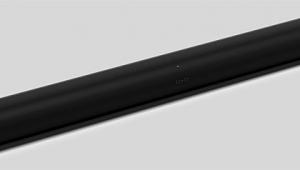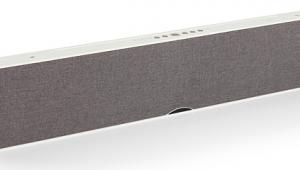Definitive Technology SoloCinema XTR Soundbar

History is so yesterday. After all, there’s no reason to learn about it when we can do nothing and watch it repeat itself. Still, I oftentimes get sucked into watching documentaries and other fanciful re-creations of people and what they did in the past. The other day, for instance, I saw an episode of Nova called “The Secrets of the Viking Sword.” Evidently, over a thousand years ago, a certain privileged few Vikings wielded their era’s ultimate weapon: the Ulfberht sword. Made from a very high-carbon steel, known as crucible steel, the blades of these swords bent rather than broke when stuck in an enemy’s shield, were longer but just as light as contemporary swords, and were able to nicely penetrate the chain mail on an unfortunate opponent’s chest. In a medieval version of branding, the swords had the name Ulfberht inlaid in large letters along the blade near the hilt.
One historically enigmatic thing about crucible steel is that after the Vikings stopped making the Ulfberht sword around 1000 AD, such high-quality steel wasn’t produced again in Europe for 800 years. (See, history repeats itself.) Now, you and I both know that the knowledge of how to make and work with this type of steel was given to the violence-prone Norsemen by meddling ancient aliens who had nothing better to do than stir up trouble and watch guys wearing horned hats raid neighboring settlements and whack each other senseless. (It’s so obvious, Nova didn’t bother to mention it.) But that’s not the point. What I found most fascinating about the Ulfberht sword is the fact that there were knockoff versions in circulation. The real deal with the real steel was emblazoned with the name Ulfberht spelled “+Ulfberh+T.” The counterfeit swords, made from much lower-carbon, inferior-quality, brittle steel, sported the oh-so-similar Ulfberht; but it was spelled “+Ulfberht+,” with the “+” at the end. Like the guy who buys an imitation Rolex, the Viking who swung a phony Ulfberht might have felt like he got a great deal—until the cheaper-steel blade shattered, and the blond-headed cheapskate’s relatives had to start shopping for an inexpensive burial shroud at the local NorseMart.
In some segue-providing sense, soundbars are the bogus +Ulfberht+ surround sound systems of home theater. They promise to give a full home theater experience with much less complication and confusion—and usually at a much lower price—than a traditional home theater system’s AVR and multiple speakers would cost. But when the battle is on and the music or sound effects in the surround channels are supposed to cover your back, the differences between the real steel of dedicated surround speakers and the weaker deal of simulated surround channels become as plain as the fear on that Haraldsslætten-coin-pinching Viking’s face when his fake sword snaps in his hand. Soundbars certainly have their place in the home theater world, however. The trick is to find one that provides—in addition to the standard virtues of musicality, dynamic range, a wide soundstage, etc.—the deepest, most detailed surround field possible. It’s tough, though, because even the best soundbars I’ve heard are only capable of extending the soundfield from the front of the room to the sides of your head, and not an earlobe farther back.

Going Solo
Definitive Technology’s newest soundbar, the SoloCinema XTR, is the company’s first to include all the amplification, audio processing, and video switching together in one unit. It also comes with its own dedicated wireless subwoofer. In a world of $200 cheapo, plastic-and-hot-glue, all-in-one soundbars, the $1,599 SoloCinema XTR might seem a little pricey. But there’s quite a bit more than sleek looks and that new big “D” logo that you get for the money. The SoloCinema XTR, for instance, has a highgloss black aluminum chassis that’s amazingly slim with a depth of only 2.38 inches when mounted on the included wall bracket. It’s not especially tall, either, at only 5.19 inches in height on the same bracket, or about the same when using the supplied feet for shelf mounting. Behind the magnetically attached grille are three 1-inch aluminum-dome tweeters—the same ones Definitive Technology uses in its tower speakers—plus six of the company’s super-shallow 3.5inch XTDD aluminum-dome midrange drivers. Inside the soundbar is an eight-pack of 25-watt Class D amplifiers. An amp is dedicated to each driver, except for the two center-channel XTDD drivers, which, like obedient twins, share an amp. Octo-amping allows Definitive Technology to forgo the use of passive crossovers or filters and instead do all signal processing and manipulation digitally.
Hidden in a recessed rectangular pocket on the back of the SoloCinema XTR are the system’s three HDMI inputs, an HDMI output, an optical digital and an analog stereo input, the connection for the power supply, and a USB port for potential future firmware updates. The bottom of the recessed pocket is open so the cables and power cord can be routed down the wall below the soundbar through some snappy cable-management kit. A conveniently placed hole in the wall-mount bracket provides ready access to the input panel from behind when professionally installing the cables inside the wall. Two keyhole slots on the back make it extremely easy to attach the speaker to the wall bracket once it is mounted in place.

Although plenty of folks have their flat-panel TVs mounted on the wall, more often than not, the TV is actually set on top of (or in) a cabinet. For this scenario, Definitive Technology includes two different shelf stands in the box with the SoloCinema XTR. One is a pair of kickstands that support the soundbar and can be adjusted to tilt the speaker upward. There’s also a pair of adjustable-height foot stands that can raise the soundbar up and over the TV’s pedestal base if it sticks out in front of the set, bringing total height to 6.69 inches. With either type of stand, plunking down a 6-something-inch-tall soundbar in front of the TV can often block the set’s IR receiver window. To alleviate this problem, there are three IR flashers integrated into the back of the speaker, which can be configured to pass through your TV remote’s IR signals—with no added cost or separate IR emitters to stick onto the TV.
Another of the SoloCinema XTR’s unusual remote-control-related aspects is the system’s ability to recognize codes from one of your existing remote controls. Essentially, this means you can reverse-engineer the SoloCinema XTR and make it respond to the remote control you use the most (TV? Cable box? Satellite? Disc player?) as if it were the original Definitive Technology remote. And this is regardless of whether or not your remote control is a programmable/learning model.
- Log in or register to post comments





































































